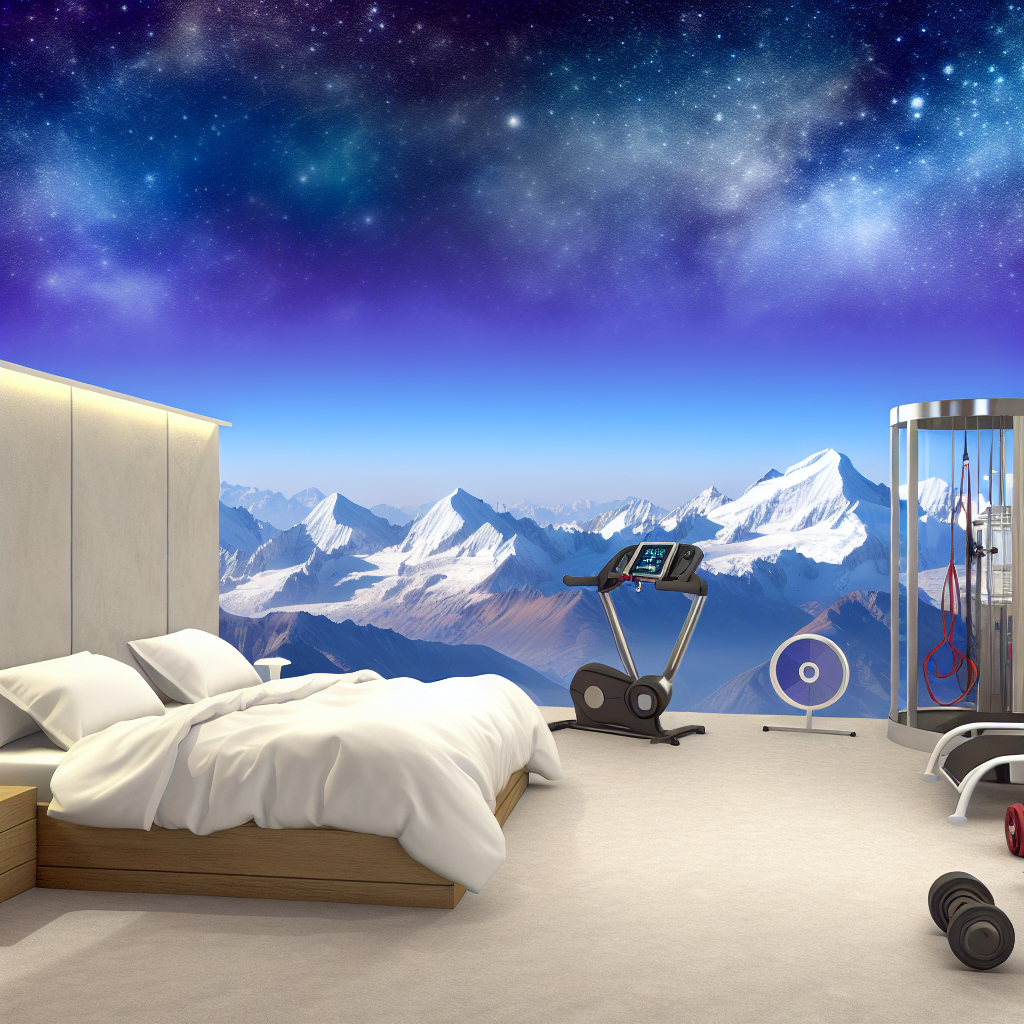Hypoxic Sleep Environments: High-Altitude Simulation for Enhanced Recovery
Introduction
Sleep is a fundamental pillar of health, affecting everything from cognitive function and emotional stability to physical recovery and immune resilience. With advances in sleep science, researchers have been exploring the impact of different environmental factors on restorative sleep, including air quality, room temperature, and oxygen levels. One particularly intriguing concept is hypoxic sleep environments—settings that mimic high-altitude conditions to alter the body’s oxygen intake during sleep.
Hypoxic sleep environments aim to simulate high-altitude conditions where oxygen levels are lower than those at sea level. These simulated environments have gained attention for their potential benefits in athletic recovery, cardiovascular health, and even sleep optimization. By exposing individuals to mild hypoxia while sleeping, the body can stimulate adaptations similar to those experienced by elite athletes training in high-altitude conditions. This may lead to increased red blood cell production and improved oxygen utilization, enhancing endurance, recovery, and overall physiological resilience.
Athletes have long known the advantages of altitude training, where reduced oxygen availability prompts the body to work harder to transport and utilize oxygen efficiently. However, advancements in technology now allow individuals to experience these benefits without traveling to high-altitude locations. Hypoxic sleep chambers, altitude tents, and specialized oxygen-controlled rooms are now being used by athletes, biohackers, and wellness enthusiasts seeking enhanced recovery and performance.
Beyond sports, hypoxic sleep environments may offer therapeutic benefits for medical conditions such as sleep apnea, metabolic disorders, and cardiovascular diseases. Studies suggest that controlled exposure to mild hypoxia may improve mitochondrial function, enhance cellular repair, and increase erythropoietin (EPO) production—a hormone involved in red blood cell formation. Additionally, researchers are investigating whether hypoxic exposure may reduce the risk of neurodegenerative diseases or improve sleep in individuals sensitive to atmospheric changes.
With growing interest in sleep science and performance optimization, key questions arise:
– How does oxygen-restricted sleep influence recovery?
– Can it truly enhance endurance and cardiovascular health?
– Is it a safe and practical strategy for non-athletes seeking better sleep and overall well-being?
This article will explore the science behind hypoxic sleep environments, highlight scientific studies that support their use, and assess the potential risks and benefits of this emerging sleep-enhancing strategy.
The Science Behind Hypoxic Sleep Environments
Several studies have examined the effects of altitude simulation during sleep, particularly in relation to athletic performance, physiological adaptation, and sleep quality. These studies reveal how hypoxic sleep may enhance recovery, improve cardiovascular function, and even boost cognitive abilities over time.
Boosting Endurance: Hypoxic Sleep and Red Blood Cell Production
A notable study published in the Journal of Applied Physiology investigated the impact of prolonged hypoxic sleep exposure on endurance athletes. The findings showed that sleeping at a simulated altitude of 2,500–3,000 meters above sea level for several weeks significantly increased erythropoietin (EPO) levels. This led to a higher concentration of red blood cells and improved oxygen transport capacity.
For endurance athletes, this adaptation is crucial because efficient oxygen delivery enhances stamina, reduces fatigue, and accelerates recovery after intense training.
Cardiovascular Benefits: Improved Heart Health with Hypoxic Sleep
In a study by the University of Colorado Boulder, researchers analyzed how simulated altitude sleeping influences sleep quality and cardiovascular function. Initial exposure led to mild sleep disturbances due to oxygen fluctuations; however, long-term adaptation resulted in:
– Improved autonomic nervous system regulation
– Enhanced cardiovascular efficiency
– Lower resting heart rate and better oxygen utilization (Frontiers in Physiology)
These findings suggest that controlled hypoxic environments could promote heart health benefits, not just for athletes, but also for individuals with cardiovascular conditions.
Faster Recovery: Hypoxic Sleep and Muscle Repair
A European Journal of Sport Science study examined the connection between intermittent hypoxia and muscle recovery. Athletes who slept in hypoxic conditions several days per week for a month showed significant improvements in key post-exercise recovery markers:
– Reduced inflammation levels
– Decreased muscle soreness
– Faster post-workout recovery
This indicates that mild hypoxia during sleep could be a powerful recovery tool for anyone engaged in strength training, endurance sports, or intense physical activity.
Therapeutic Applications: Can Hypoxic Sleep Help Sleep Apnea?
Beyond athletic performance, research suggests that hypoxic sleep environments may have therapeutic implications for individuals with sleep apnea. A study by the University of Zurich explored how controlled hypoxia affects patients with obstructive sleep apnea (OSA). The results revealed that intermittent hypoxic exposure during sleep helped:
– Improve the body’s ability to tolerate oxygen deprivation
– Reduce the severity of apnea-related breathing disruptions (Respiratory Physiology & Neurobiology)
These findings open new possibilities for alternative, non-invasive treatments for OSA sufferers.
Neuroprotective Benefits: Could Hypoxic Sleep Reduce the Risk of Alzheimer’s?
Recent studies suggest that intermittent hypoxia may have neuroprotective properties. Research published in Neurobiology of Aging suggests that controlled hypoxia exposure during sleep can:
– Trigger mitochondrial biogenesis to enhance brain energy metabolism
– Promote brain plasticity and cognitive resilience
– Potentially reduce the risk of neurodegenerative conditions like Alzheimer’s and Parkinson’s
Although more research is necessary, these findings indicate fascinating future directions for hypoxic sleep in brain health.
Conclusion: Is Hypoxic Sleep the Future of Sleep Optimization?
Hypoxic sleep environments are at the cutting edge of sleep science and recovery, offering promising benefits for:
✅ Athletes looking to enhance endurance and optimize recovery
✅ Individuals with cardiovascular conditions wanting better oxygen utilization
✅ People searching for innovative approaches to boost sleep quality and well-being
Simulating high-altitude conditions stimulates red blood cell production, enhances cardiovascular efficiency, and accelerates muscle recovery. However, hypoxic sleep is not a one-size-fits-all solution—individual responses to reduced oxygen levels vary, and prolonged exposure should be monitored for safety.
For those considering hypoxic sleep, consulting a sleep specialist or medical professional is recommended. As technology progresses and research deepens, this approach could become an essential tool for enhancing recovery, performance, and long-term health.
Summary:
Hypoxic sleep environments, which simulate high-altitude conditions, offer promising benefits for athletes, individuals with cardiovascular conditions, and those seeking better sleep and overall well-being. Studies show that exposure to mild hypoxia during sleep can boost endurance, improve cardiovascular function, accelerate muscle recovery, and even have therapeutic applications for conditions like sleep apnea and neurodegenerative diseases. While not a one-size-fits-all solution, hypoxic sleep is an emerging sleep-enhancing strategy that could become an essential tool for optimizing recovery, performance, and long-term health.

Dominic E. is a passionate filmmaker navigating the exciting intersection of art and science. By day, he delves into the complexities of the human body as a full-time medical writer, meticulously translating intricate medical concepts into accessible and engaging narratives. By night, he explores the boundless realm of cinematic storytelling, crafting narratives that evoke emotion and challenge perspectives.
Film Student and Full-time Medical Writer for ContentVendor.com




